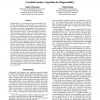Free Online Productivity Tools
i2Speak
i2Symbol
i2OCR
iTex2Img
iWeb2Print
iWeb2Shot
i2Type
iPdf2Split
iPdf2Merge
i2Bopomofo
i2Arabic
i2Style
i2Image
i2PDF
iLatex2Rtf
Sci2ools
AAAI
2008
2008
A Scalable Jointree Algorithm for Diagnosability
Diagnosability is an essential property that determines how accurate any diagnostic reasoning can be on a system given any sequence of observations. An unobservable fault event in a discrete-event system is diagnosable iff its occurrence can always be deduced once sufficiently many subsequent observable events have occurred. A classical approach to diagnosability checking constructs a finite state machine known as a twin plant for the system, which has a critical path iff some fault event is not diagnosable. Recent work attempts to avoid the often impractical construction of the global twin plant by exploiting system structure. Specifically, local twin plants are constructed for components of the system, and synchronized with each other until diagnosability is decided. Unfortunately, synchronization of twin plants can remain a bottleneck for large systems; in the worst case, in particular, all local twin plants would be synchronized, again producing the global twin plant. We solve the...
| Added | 02 Oct 2010 |
| Updated | 02 Oct 2010 |
| Type | Conference |
| Year | 2008 |
| Where | AAAI |
| Authors | Anika Schumann, Jinbo Huang |
Comments (0)

